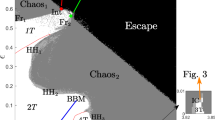Abstract
Hebbian dynamics is used to derive the differential equations for the synaptic strengths in the neural circuitry of the locomotive oscillator. Initially, neural connection are random. Under a specified arborization hypothesis relating to the density of neural connections, the differential equations are shown to model the self-organization and the stability of the oscillator.
Similar content being viewed by others
References
Edelman, G. M., Neural Darwinism: The Theory of Neuronal Group Selection, Basic Books, New York, 1987
Edelman, G. M., Topobiology, Basic Books, New York, 1988
Hebb, D. O., The Organization of Behavior, J. Wiley, New York, 1949
Linsker, R., Self-Organization in a Perceptual Network Computer, pp. 105–117, March 1988
Miller, S., Scott, P. D., The Spinal Locomotor Generator Experimental Brain Research, 30, pp. 387–403, 1987
Willner, B. E., Miranker, W. L., Lu, C.-P., Neural Organization of the Locomotive Oscillator, J. Biol. Cyb. 68, pp. 307–320, 1993
Author information
Authors and Affiliations
Rights and permissions
About this article
Cite this article
Willner, B.E., Lu, CP. & Miranker, W.L. Self-organization of an oscillatory neural system. J. Math. Biol. 33, 829–866 (1995). https://doi.org/10.1007/BF00187284
Received:
Revised:
Issue Date:
DOI: https://doi.org/10.1007/BF00187284




